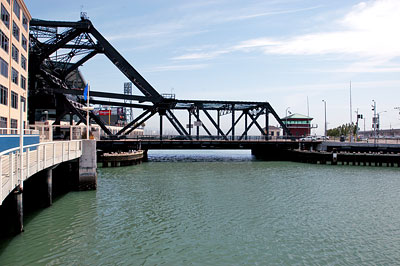San Francisco Landmarks
Third Street Bridge
Rechristened Francis "Lefty" O'Doul Bridge in 1969
Third Street Over Mission Creek
Ribbon Cutting 1933
The main span over the shipping channel consists of a 143 foot through riveted steel single leaf bascule truss, complete with electrically driven hoist machinery.
Approach spans consist of four 23 foot concrete girder spans at the south end and one 54.5 foot riveted steel girder span at the other end. All rest on concrete substructures supported on driven timber piles. Timber fenders on each side of the 104 foot channel protect the bridge which holds four automobile lanes, one set of railroad tracks, and sidewalks.
Two small harbor master's cottages known as the Operator's and Watchman's Houses are original and extant; both are supported on the bridge piers.
The Lefty O'Doul Bridge is a heel trunnion type bascule drawbridge designed and patented by the Strauss Engineering Corporation.
A heel trunnion is a pivot mounted on bearings and a bascule bridge has one end is weighted to counter balance the structure on the other end when the bridge is open.
Bridges of this type used reinforced concrete for counterweights rather than more expensive iron. Heel trunnions required no pit to receive the counter weight. The design increased navigational clearance since the truss trunnion was on the upper not the lower chord. Foundations are simplified. Moving parts are accessible for maintenance.
But the design lacks grace and was used only where appearance was secondary to cost and efficiency.
This is the only bridge of this type in the vicinity of San Francisco although sixteen steel truss bascules remain in California today, nine of them designed by Strauss. Four were built by Strauss between 1923 and 1929 along the Sacramento River.
The Lefty O'Doul bridge is the last of this type that Strauss designed.
Source: Planning Commission Resolution No. 11629 dated 6 April 1989.

Joseph Baerman Strauss (1870-1938) designed more than four hundred bridges including the Golden Gate Bridge. His bronze statute stands in a garden at the San Francisco end of the Golden Gate Bridge.
From 1921 to 1938 he lived in San Francisco. His health began to fail soon after construction was started on the Golden Gate Bridge. Some believed the stress of the job was the cause. He died in Los Angeles on May 16, 1938 of a heart attack, just one year after bridge was completed.
Source: Planning Commission Resolution No. 11629 dated 6 April 1989.

Francis "Lefty" O'Doul (1896-1969) was born in the Butchertown (Bay View) District of San Francisco.
He began his baseball career as a left-handed pitcher with the Seals, went to the New York Yankees, then, after hurting his arm, became an outfielder and great batter for Philadelphia and Brooklyn.
He twice won the National League batting championship. He later managed various teams, including the Seals for seventeen years, winning three pennants. His proteges included Joe DiMaggio and Willie Mccovey. He helped introduce baseball to Japan. In 1949 he won the Bing Crosby golf tournament. In twenty years of professional play with the Seals and in the major leagues, he accumulated a lifetime batting average of .351.
Venerable Lefty O'Doul's Bar and Restaurant and the Lefty O'Doul Bridge are familiar local sites which bear his name.
The San Francisco Seals were a AAA league baseball team in the Pacific Coast League. It was the City's Club (1903-1958) until the transfer of the major league Giants to San Francisco. The name Seals was later given to the Oakland Ice Hockey team.
Source: Planning Commission Resolution No. 11629 dated 6 April 1989.
